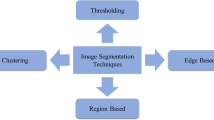Abstract
Signatures, in this work, are multi-scale representations of local gray-level information, tied to places in gray scale images where regional differences are locally maximal. The information may involve the regional differences themselves (called Gaussian differences or signed normalized gradient magnitudes, (Korn, 1988)), or, distance relations between edges (apparent width measurements), or, absence of edges in pulse edge pairs, at coarser scales. Using signatures involves the classical problem mentioned by Marr and others of relating information across scales. A novel result is that a fruitful way of doing this is to build scale paths from coarse-to-fine exploiting edge focusing and associate with pixel positions, along these paths, the three quantities Gaussian differences, apparent width and the binary information absence/presence of edges (in edge-pairs). Such a structure, if used together with proper conditional tests, serves the purpose of classifying edges with respect to profile-type, and can also be used for measuring global contrast, degree of diffuseness, deblurred line width, and qualitative labels such as diffuse versus sharp. The structure is used simultaneously for labelling tasks and quantitative measurements. Theory on apparent widths, absence/presence of edges in pulse edge pairs is developed. For measuring diffuseness and global contrast from Gaussian difference signatures a linear least squares approach is suggested. Extensive experimental results are presented. Possible applications are in image segementation, junction analysis, and depth-from-defocus. For the purpose of distinguishing between objects and illumination phenomena, such as diffuse shadow edges, classification of contours with respect to diffuseness seems useful.
Similar content being viewed by others
References
Adjouadi, M. 1985. Shadow analysis in scene interpretation. In Proc. of 4th Scandinavian Conf., Trondheim, Norway, pp. 821-829.
Back, S., Neumann, H., and Stiehl, H. S. 1989. On scale-space edge detection in computed tomograms. 11 DAGM-Symposium Mustererkennung.
Bergholm, F. 1987. Edge focusing. IEEE. Trans., PAMI-9(6):726- 741.
Bergholm, F. and Rohr, K. 1991. A comparison between two approaches applied for estimating diffuseness and height of step edges. Tech. Report, TRITA-NA-P9105, Royal Inst. of Tech., Stockholm. Also hausbericht, fraunhofer-institute für informtionsund datenverarbeitung, Nr. 10262, Karlsruhe.
Blake, A. and Zissermann, A. 1987. Visual Reconstruction. MIT Press: Cambridge, Massachusetts, London, England.
Canny, J. F. 1986. Acomputational approach to edge detection. IEEE. Trans., PAMI-8(6).
Freeman, W. T. and Adelson, E. H. 1991. The design and use of steerable filters IEEE. Trans., PAMI-13(9):891-906.
Grossman, P. 1987. Depth from focus. Pattern Recognition Letters, 5:63-69.
Gülch, E. and Axelsson, P. 1990. Report on OEEPE test on feature based segmentation. Tech. Report, Photogrammetry, Royal Institute of Technology, Sweden.
Kisworo, M., Venkatesh, S., and West, G. 1994, Modeling edges at subpixel accuracy using local energy approach. IEEE. Trans., PAMI-16 (4):405-410.
Kmenta, J. 1971. Elements of Econometrics. Macmillan Publ. Co.: New York, NY.
Korn, Axel F. 1988. Toward a symbolic representation of intensity changes in images. IEEE. Trans., PAMI-10(5):610-625.
Lai, S. H., Fu C. W., and Chang, S. 1992. A generalized depth estimation algorithm with a single image. IEEE. Trans., PAMI-14: 405-411.
Lindeberg, T. P. 1994. Scale-Space Theory in Computer Vision. Kluwer Academic Publishers: Dordrecht, The Netherlands.
Lu, Y. and Jain, R. C. 1992. Reasoning about edges in scale space, IEEE. Trans., PAMI-14:450-468.
Mallat, S. and Zhong, S. 1992. Characterization of signals from multiscale edges. IEEE. Trans., 7 PAMI-14:710-732.
Mallat, S. and Hwang, W. L. 1992. Singularity detection and processing with wavelets. IEEE. Trans., Information Theory, 38(2):617- 643.
Marr, D. G. 1976. Early processing of visual information. Phil. Trans. of the Royal Society of London, 275:97-137.
Pahlavan, K. and Eklundh, J. O. -. A head eye system-Analysis and design, CVGIP: Image Understanding, 56(1):41-56.
Pentland, A. 1987. A new sense for depth of field. IEEE. Trans., PAMI-9:523-531.
Perona, P. and Malik, J. 1990. Detecting and localizing edges composed of steps, peaks and roofs. In Proc. 3rd ICCV, Osaka, Japan.
Raman, S. V., Sarkar, S., and Boyer, K. L. 1993. Hypothesizing structures in edge-focused cerebral magnetic resonance images using graph-theoretic cycle enumeration. Computer Vision, Graphics, and Image Processing, 57(1):81-98.
Rohr, K. 1990. Ñber die modellierung und identifikation charakteristischer grauwertverläufe in realweltbildern. 12 DAGM-Symposium Mustererkennung.
Rohr, K. 1992a. Recognition corners by fitting parametric models. International Journal of Computer Vision, 9(3):213-230.
Rohr, K. 1992b. Modelling and identification of characteristic intensity variations. Image and Vision Computing, 10(2):66-76.
Sjöberg, F. and Bergholm, F. 1988. Extraction of diffuse edges by edge focusing. Pattern Recognition Letters, 7:181-190.
Watt, R. J. and Morgan, M. J. 1985. A theory of the primitive spatial code in human vision. Vision. Res., 23:1661-1674.
Watt, R. J. 1988. Visual Processing: Computational Psychophysical and Cognitive Research. Lawrence Erlbaum Associates, Publishers.
Williams, D. J. and Shah, M. 1990. Normalized edge detector. 10th ICPR, Atlantic City: New Jersey, U. S. A., pp. 942-946.
Williams, D. J. and Shah, M., CVGIP:1990. Edge contours using multiple scales., CVGIP, 51:256-274.
Williams, D. J. and Shah, M. 1993. Note: Edge characterization using normalized edge detector. CVGIP: Graphical Models and Image Processing, 55(4):311-318.
Witkin, A. P. 1982. Intensity-based edge classification. In Proc. of AAAI'82, pp. 36-39.
Witkin, A. P. 1982. Scale space filtering. In Proc. of IJCAI, Karlsruhe, pp. 1019-1021.
Zhang, W. 1995. Understanding intensity and illumination transitions, Ph. D. Thesis, TRITA-NA-P9518, ISSN 1101-2250, NADA, KTH, Stockholm, Sweden.
Zhang, W. and Bergholm, F. 1991. An extension of Marr's "signature' based edge classification. In Proc. of SCIA '91, Aalborg, Denmark, pp. 435-443.
Zhang, W. and Bergholm, F. 1993a. An extension of Marr's "signature' based edge classification and other methods determining diffuseness and height of edges, and bar edge width. In Proc. of ICCV, Berlin, pp. 183-191.
Zhang, W. and Bergholm, F. 1993b. Multi-scale blur estimation and edge type classification for scene analysis. Tech. Report, TRITANA-P9330 NADA, Royal Institute of Technology, Sweden.
Author information
Authors and Affiliations
Rights and permissions
About this article
Cite this article
Zhang, W., Bergholm, F. Multi-Scale Blur Estimation and Edge Type Classification for Scene Analysis. International Journal of Computer Vision 24, 219–250 (1997). https://doi.org/10.1023/A:1007923307644
Issue Date:
DOI: https://doi.org/10.1023/A:1007923307644




